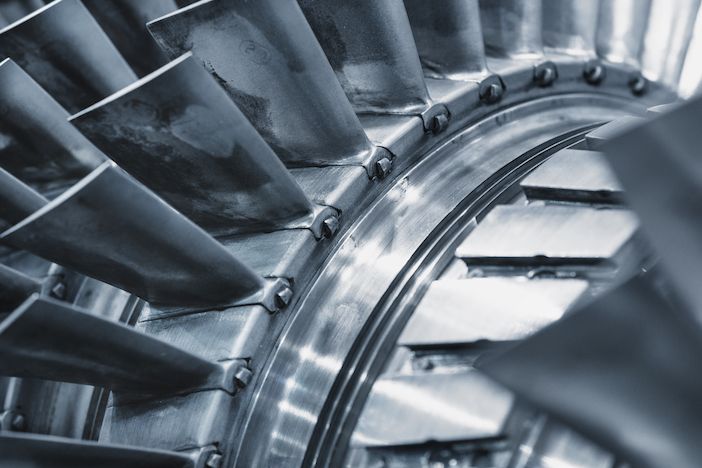by Peter Bailey
The undertaking of Low Cycle Fatigue (LCF) testing at elevated temperatures of up to 1000°C has been an important part of aero-engine development for decades. The role LCF testing plays in most programs is to simulate the aggressive loading conditions seen by materials in critical turbine components, generating data for use in material or process selection, batch release, or more recently for simulation.
A drive for greater fidelity in simulation of aero-engines has led to a renewed focus on LCF test data. One of the underlying motivations is the demand for lower carbon emissions. The use of structural composites has delivered impressive aircraft weight reductions but improving the efficiency of aero-engines also offers a viable way for aircraft to reduce carbon emissions.
A small increase in useable temperature in the right place can provide a measureable improvement in efficiency.
Statistical confidence
All material fatigue behaviour shows scatter or distribution, so design and simulation use statistical confidence limit values to account for this. However, not all of the scatter is true material variability – sometimes design allowables can be improved simply by collecting better data!
Engineers can often focus obsessively on simple accuracy, but the realization has hit home that this alone is not enough – repeatability is also vital. The routes to improvement distil down to better mechanical and thermal controls, but their implications may not be what you expect.
Eliminate variability and achieve repeatability
Materials testing company Instron, working in partnership with its customers, has identified and addressed three key areas which have challenged manufacturers and test practitioners over past decades.
Firstly, gripping and alignment of specimens is a major source of variability. Many theoretically sound grip designs have been used in the past, but they do not necessarily help repeatable loading.
Essentially, the design must use appropriate locating features on the specimen, applying tight tolerances to both grip and specimen and a clamping action without any off-axis motion. Simultaneously, high lateral stiffness of the whole system is needed to retain that alignment during a test – it is important to realise that most of the lateral compliance at the specimen is not from the load frame, but rather from flexure of pull rods and drive train.
Secondly, the fidelity of mechanical test control is important. This may seem obvious, but it is not trivial to achieve, unless the test frames control system is tuned effectively and consistently.
It has been common practice to allow the first ten fatigue cycles considerable latitude to “envelope” towards the target loading, yet these early cycles are often the most critical, when the material is changing most rapidly (hardening or softening). Tuning was historically a skilled operation, where “good” was highly subjective.
Instron’s latest stiffness based tuning algorithms feature removes the risk of overloading or pre-cycling a specimen during test setup and achieve near-identical test control between different operators, machines and even laboratories.
 Thirdly, Instron has completely automated the control of specimen temperature. Furnace control hardware in most laboratories has remained surprisingly primitive, manually controlling the furnaces three zones independently and requiring extensive, skilled, time consuming pre-test work. Furnace control systems can be delivered fully pre-tuned and use multiple specimen temperature measurements to adaptively control the furnace without any operator intervention.
Thirdly, Instron has completely automated the control of specimen temperature. Furnace control hardware in most laboratories has remained surprisingly primitive, manually controlling the furnaces three zones independently and requiring extensive, skilled, time consuming pre-test work. Furnace control systems can be delivered fully pre-tuned and use multiple specimen temperature measurements to adaptively control the furnace without any operator intervention.
Each test is automatically conducted at the intended temperature, with faster heating times whilst minimising temperature overshoot and specimen gradient. The computerised interface means that features such as thermocouple calibrations can be added and a wide variety of metrics can be logged, greatly improving traceability.
These recent advances have addressed industries needs to drive improvement in test equipment, improving the consistency of their test data by removing the hidden effects of alignment, test control, and temperature control.
 Dr Peter Bailey is senior applications specialist at Instron Dynamic Systems . An experimental materials scientist focusing on advanced mechanical testing and characterisation techniques, he works on all types of material analysis, including high temperature metals. His background includes considerable experience in polymers and composites research and a variety of production and quality control methods for thermoplastics and thermosets.
Dr Peter Bailey is senior applications specialist at Instron Dynamic Systems . An experimental materials scientist focusing on advanced mechanical testing and characterisation techniques, he works on all types of material analysis, including high temperature metals. His background includes considerable experience in polymers and composites research and a variety of production and quality control methods for thermoplastics and thermosets.





